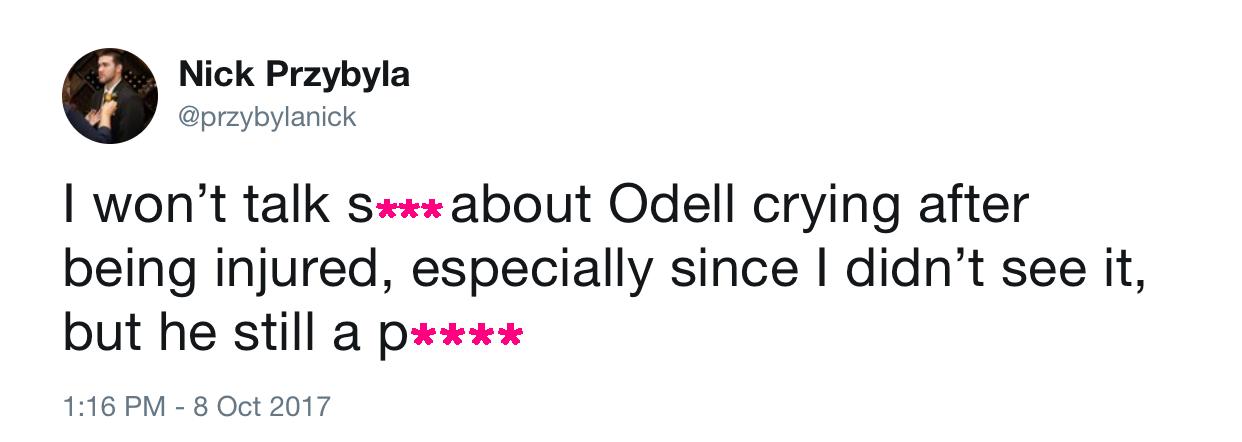
4 minute read
Toxic Tweets: The Looming Danger of Social Media
Johnsen Del Rosario
Social media is one of the most powerful tools at our disposal today, and it’s readily available with the touch of a screen. It has the power to connect people, break news as it happens, create change, start national movements and even identify people faster than the police can.
Advertisement
But despite all the good it can do, it’s also a place full of trolls and hate.
With the ability to hide behind a screen, social media becomes a place where users feel free to say whatever they want without consequences, often leading to posts that promote toxic masculinity.
In October 2017, New York Giants wide receiver Odell Beckham Jr. was captured on camera crying, not once, but on two different occasions during a game against the Los Angeles Chargers.
During the third quarter, Beckham got emotional on the sidelines and started crying. The reason behind the strenuous process to unlearn it.
Later that same game, cameras panned on Beckham crying again as he was being carted off the field with what was later confirmed as a fractured left ankle ending his 2017 season.
That’s when social media went on frenzy -- and it reeked of toxic masculinity.
The ridicule Beckham received for crying on the field -- even after a season-ending injury -- is just one example of the role toxic masculinity plays on social media.

We are exposed to more toxicaly masculine tweets and posts than ever before, especially with today’s political climate.
Donald Trump and his
How did Trump respond? By tweeting this:
“North Korean Leader Kim Jong Un just stated that the ‘Nuclear Button is on his desk at all times.’ Will someone from his depleted and food starved regime please inform him that I too have a Nuclear Button, but it is a much bigger & more powerful one than his, and my Button works!” tears are unknown, but then-teammate Brad Wing, who also played with Beckham at Louisiana State University, was seen consoling him from behind.
Like clockwork, people took to social media, mainly Twitter, and began criticizing Beckham for being overly-emotional, calling him a “little girl” or “p****” and telling him to “man up”.

As children, young boys are taught by their parents, the media and institutions that boys don’t cry, and if they show any sign of emotion or vulnerability, they are considered weak and are told to “stop acting like a girl”.
And once you’re taught something, especially when you’re at your most susceptible age, it can be a administration uses their online presence to spread toxicity, whether on purpose or not, especially when their masculinity is attacked or diminished.
Earlier this year, North Korea leader Kim Jong-un threatened the United States, suggesting that the U.S. was within range of their nuclear weapons and had a launch button always ready on his table.
Trump taunting Kim Jong-un saying his button is bigger and more powerful is proof that toxic masculinity may get us all killed one day.
Comparing whose is bigger and more powerful takes me back to the boy’s locker room in high school. It’s childish and immature, except now, it could get people killed. But as we all learned from the interview with Billy Bush, Trump loves his locker room talk.
With a president that is the perfect embodiment of what toxic masculinity is, it’s no surprise that people will follow in his footsteps in this sense too.
Back in April, Twitter user @MagaFrank2 (whose account has since been suspended), tweeted videos and photos of himself using a giant picture of David Hogg’s head as a target practice at a gun range.

If you are unaware of who David Hogg is, he is a survivor of the school shooting in Parkland, Florida that killed 17 students and staff earlier this year. Hogg, along with other classmates, have made names for themselves as gun-reform activists, going after and demanding change from politicians and organizations like the National Rifle Association (NRA).
How bruised does your ego and masculinity have to be for you to use an effigy of a teenage survivor of a mass shooting as target practice and somehow think that that’s okay?
Mass shootings, rape culture, domestic violence -toxic masculinity is the common theme and it is killing us. To these men, if they don’t have or are losing power and control or if they feel their manhood is being questioned, threatened or attacked, they resort to violence in order to reaffirm their masculinity and women, children and other men -- they pay the price.
And with social media, this toxicity becomes more widespread, reaching more people than just the intended audience. These words, photos and videos can become detrimental to one’s mental health and physical safety.
Reimagining Masculinity
Patrick Antunez

With the election of a president who displays some of the worst qualities of being a man - sexually aggressive, dismissive of women, bullying the vulnerable and aggressive towards criticism - the conversation of masculinity must be discussed as we continue heading backwards in social evolution.
Masculinity is not historically toxic, but has evolved that way in our culture, forming into this tough knowit-all view of being a ‘real man’. The type of man that only has the emotional expression of anger fueling his thirst to be the alpha male, creating a platform for more toxic behaviors to evolve.
The evolution has established a harmful environment that is problematic to everyone. Domestic violence and violence in general increases with behaviors such as bullying, hypercompetitiveness and reducing women to body parts and sex. Brock Turner sexually assaulting an unconscious woman is a clear example of how toxic masculinity manifests.
With all of this toxicity from a subsection of masculinity, we must shift from our preconceived notions of what masculine and feminine should look like.
Men, like women, have their own strengths. Men are stronger in some aspects and women are stronger in most aspects. But having people categorized as “masculine’’ or ‘’feminine’’ based on anatomy is confusing to those who don’t fit that role.
Realizing this could be the first step in reimagining the stereotypical know-it-all tough guy and tackling toxic behaviors.
Breaking the anatomically-based gender buckets that is forced upon people would do away with this because men and women would be able to define themselves without the pressure of societal standards and all the dissatisfaction it brings.
Masculinity, not generalized to a gender, has many great qualities such as independence, confidence and passion, which are not toxic and positively impact to everyone. Without the frustrations of fitting into a social construct, masculines would be free and not have to resort to violence.
Breaking these anatomical based categories is a start to tearing down toxic masculinity. It would give individuals the power to define masculinity in their own right; reimagining masculinity that is true to the individual and positive to everyone.
Social media is a powerful weapon to have in our arsenal, but depending on how it is utilized, it can also be one of our greatest weaknesses.









